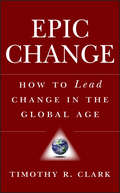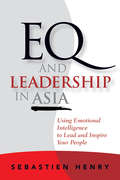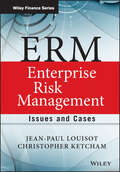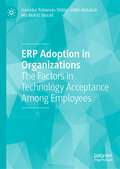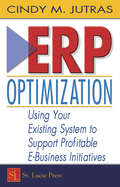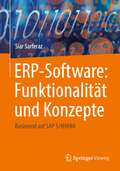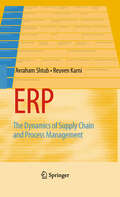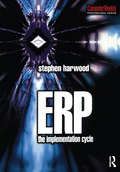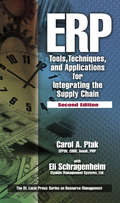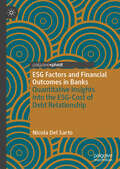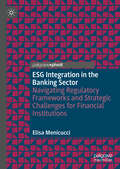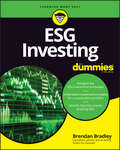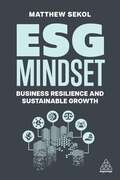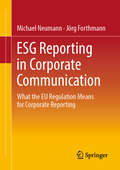- Table View
- List View
ENSR International
by David B. GodesWhat is the best way to "sell" consulting services? Should the firm focus on key accounts? Should it have dedicated salespeople? How should the firm account for "selling" activities in its compensation plan? ENSR is an environmental consulting firm located in Westford, MA. It consults on a variety of topics, such as air and water qualit, wildlife resource management, and workplace safety. As a result, its 1,000 consultants are drawn from very diverse backgrounds. The firm's top management seeks to deliver sales and utilization growth from this complex organization. The question is how should they do it?
EPIC Change
by Timothy R. Clark"More than ever, leaders are expected to be the change agents of their organizations. Yet CEO turnover continues to rise and organizations continue to struggle in their efforts to confront the fearsome adaptive challenges of the global age. Epic Change is a path-breaking contribution to the study of leadership and organizational change. Based on a landmark study of 53 cases of large-scale organizational change in business, healthcare, government, education, and the non-profit sector, acclaimed thought leader and researcher, Dr. Timothy R. Clark unveils the "Power Curve of Change" framework and EPIC system for change management (Evaluate, Prepare, Implement, Consolidate) for leaders who are charged to lead high-stakes change initiatives in their organizations. Epic Change presents a strategic-level road map, along with tactical level tools, for the every-day needs of leaders who must respond to all types of adaptive challenge to remain competitive. It represents a comprehensive, research-based program for leaders who want to develop the indispensable competency of leading change in a permanently and profoundly different age.Change rarely fails for lack of strategy--Clark shows that only the discretionary efforts of people can make change happen--and this requires leadership and energy management. The Epic Change approach has been successfully field-tested with leaders at all levels and in organizations around the world. This important resource provides leaders new research-based tools to increase and sustain the energy of any change effort."
EQ and Leadership In Asia
by Sebastien HenryIncrease your emotional intelligence, build a better workplaceEmotional intelligence is crucial for business leadership, and nowhere is that more true than in Asia, where emotions are particularly likely to be concealed during daily business interactions. Emotions can be a major asset for leaders if properly understood, and a source of significant disruption if they are ignored. EQ and Leadership in Asia provides business leaders in Asia with the keys to using emotions as allies as they face practical business challenges.Presenting emotional intelligence in a clear, straightforward manner that anyone can understand, the book shows what it can accomplish, why it matters, and how to systematically improve your ability to understand emotions. Looking at the real challenges that leaders in Asia have to face every day and exploring how emotional intelligence can be used in each instance, this compelling book is essential reading for leaders who want to inspire and influence their coworkers and lead their companies to greater success.Explains the key concepts of emotional intelligence and its particular importance for those in leadership positionsExplores why understanding emotion is particularly important for Asian leadersProvides practical examples of emotional intelligence techniques in action in real-world situationsA guide to emotional intelligence designed for people working in leadership positions in Asia, EQ and Leadership In Asia is the only book you need to harness emotion in order to create a better workplace.
ERISA Principles
by Peter J. Wiedenbeck Brendan S. MaherERISA, the detailed and technical amalgam of labor law, trust law, and tax law, directly governs trillions of dollars spent on retirement savings, health care, and other important benefits for more than 100 million Americans. Despite playing this central role in the US economy and social insurance systems, the complexities of ERISA are often understood by only a few specialists. ERISA Principles elucidates employee benefit law from a policy perspective, concisely explaining how common themes apply across a wide range of benefit plans and factual contexts. The book's non-technical language and cross-cutting conceptual organization reveal latent similarities and rationalize differences between the regulatory treatment of apparently disparate programs, including traditional pensions, 401(k), and health care plans. Important legal developments - whether statutory, judicial, or administrative - are framed and analyzed in an accessible, principles-centric manner, explaining how ERISA functions as a coherent whole.
ERM - Enterprise Risk Management
by Jean-Paul Louisot Christopher H. KetchamA wealth of international case studies illustrating current issues and emerging best practices in enterprise risk managementDespite enterprise risk management's relative newness as a recognized business discipline, the marketplace is replete with guides and references for ERM practitioners. Yet, until now, few case studies illustrating ERM in action have appeared in the literature. One reason for this is that, until recently, there were many disparate, even conflicting definitions of what, exactly ERM is and, more importantly, how organizations can use it to utmost advantage. With efforts underway, internationally, to mandate ERM and to standardize ERM standards and practices, the need has never been greater for an authoritative resource offering risk management professionals authoritative coverage of the full array of contemporary ERM issues and challenges. Written by two recognized international thought leaders in the field, ERM-Enterprise Risk Management provides that and much more.Packed with international cases studies illustrating ERM best practices applicable across all industry sectors and business modelsExplores contemporary issues, including quantitative and qualitative measures, as well as potential pitfalls and challenges facing today's enterprise risk managersIncludes interviews with leading risk management theorists and practitioners, as well as risk managers from a variety of industriesAn indispensable working resource for risk management practitioners everywhere and a valuable reference for researchers, providing the latest empirical evidence and an exhaustive bibliography
ERM and QRM in Life Insurance: An Actuarial Primer (Springer Actuarial)
by Ermanno PitaccoThis book deals with Enterprise Risk Management (ERM) and, in particular, Quantitative Risk Management (QRM) in life insurance business. Constituting a “bridge” between traditional actuarial mathematics and insurance risk management processes, its purpose is to provide advanced undergraduate and graduate students in the Actuarial Sciences, Finance and Economics with the basics of ERM (in general) and QRM applied to life insurance business. The main topics dealt with are: general issues on ERM, risk management tools for life insurance and life annuities, deterministic and stochastic analysis of the behaviour of a portfolio fund, application of sensitivity testing to assess ranges of results of interest, stress testing to assess the impact of extreme scenarios, and the product development process for life annuity products.
ERP Adoption in Organizations: The Factors in Technology Acceptance Among Employees
by Hamidur Rahaman Shibly ABM Abdullah Md Wahid MuradThis book examines the factors that shape the adoption and continuous usage of new technology by employees in organizations. While within an organization new technology adoption has evolved from its traditional role to a more strategic one, the appropriate adoption of new technology can only add value to organizations. Identifying the factors that influence this adoption process is crucial for successful adoption of new technology in organizations. The study presented in this book focuses on individual, organizational, social, and industrial factors and uses those to offer a comprehensive model of Enterprise Resource Planning (ERP) application adoption. It contributes towards understanding employees’ acceptance and adoption of enterprise-level technological innovation, allowing organizations to create a work environment conducive to individual implementation and acceptance of new technology. It appeals to researchers interested in studying the adoption of ERP and other innovative technologies in organizations.
ERP Optimization: Using Your Existing System to Support Profitable E-Business Initiatives
by Cindy JutrasExisting ERP systems are being used to support an increasing amount of critical e-business initiatives, even though this is far from their original purpose. While ERP can form a foundation for successfully meeting e-business needs, future success will be derived not only from a firm, supportive foundation, but from a solid e-business superstructure
ERP Systems for Manufacturing Supply Chains: Applications, Configuration, and Performance
by Odd Jøran Sagegg Erlend AlfnesERP Systems for Manufacturing Supply Chains: Applications, Configuration, and Performance provides insight into the core architecture, modules, and process support of ERP systems used in a manufacturing supply chain. This book explains the building blocks of an ERP system and how they can be used to increase performance of manufacturing supply chains. Starting with an overview of basic concepts of supply chain and ERP systems, the book delves into the core ERP modules that support manufacturing facilities and organizations. It examines each module’s structure and functionality as well as the process support the module provides. Cases illustrate how the modules can be applied in manufacturing environments. Also covered is how the ERP modules can be configured to support manufacturing supply chains. Setting up an ERP system to support the supply chain within single manufacturing facility provides insight into how an ERP system is used in the smallest of manufacturing enterprises, as well as lays the foundation for ERP systems in manufacturing organizations. The book then supplies strategies for larger manufacturing enterprises and discusses how ERP systems can be used to support a complete manufacturing supply chain across different facilities and companies. The ERP systems on the market today tend to use common terminology and naming for describing specific functions and data units in the software. However, there are differences among packages. The book discusses various data and functionalities found in different ERP-software packages and uses generic and descriptive terms as often as possible to make these valid for as many ERP systems as possible. Filled with insight into ERP system’s core modules and functions, this book shows how ERP systems can be applied to support a supply chain in the smallest of manufacturing organizations that only consist of a single manufacturing facility, as well as large enterprises where the manufacturing supply chain crosses multiple facilities and companies.
ERP-Software: Basierend auf SAP S/4HANA
by Siar SarferazEnterprise Resource Planning (ERP) ist eine Software Lösung, die alle Prozesse eines Unternehmens digitalisiert, mit dem Ziel den Automatisierungsgrad zu erhöhen. SAP bietet mit SAP S/4HANA die nächste Generation eines intelligenten ERP-Systems. Das Buch erläutert den Funktionsumfang, das Datenmodell, die Architektur, die zugrundeliegenden Engineering Konzepte und das Programmiermodell von ERP-Systemen basierend auf SAP S/4HANA.Im ersten Teil lernen interessierte Leser*innen die Marktsicht von ERP kennen. Der zweite Teil behandelt die ERP-Geschäftsprozesse für Vertrieb, Marketing, Finanzwesen, Lieferketten, Fertigung, Dienstleistungen, Beschaffung und Personalwesen. Im dritten Teil werden die zugrundeliegenden Konzepte beschrieben, z. B. In-Memory Datenbanken, Analytics und Reporting, Künstliche Intelligenz, Prozess- und Datenintegration, Sicherheit und Compliance, Lebenszyklusmanagement, Performanz und Skalierbarkeit, Konfiguration und Implementierung. Das Buch schliesst mit der Beschreibung und einer Testzugangs-Möglichkeit zur SAP Cloud Appliance Library, mit dem die Leserschaft das SAP S/4HANA System selbst erkunden kann.
ERP: The Dynamics of Supply Chain and Process Management
by Reuven Karni Avraham ShtubERP: The Dynamics of Supply Chain and Process Management is a complete updating and expansion of Avraham Shtub’s award-winning 1999 text Enterprise Resource Planning (ERP): The Dynamics of Operations Management. New chapters, written together with his co-author Reuven Karni, cover enterprise process modeling; design of business processes; a complete revision of the original chapter on the integrated order-fulfillment process using ERP; business process management; business process improvement; and a new appendix on simulating process life cycles: using serious games as teaching aids.MERPTM is designed to facilitate the teaching of integrated operations of a business organization with a focus on corporate performance management. It reflects a fully live environment and allows students to participate in a virtual organization made real and dynamic as minute-by-minute business events and conditions unfold.This book is ideal for use in academic and executive programs aimed at teaching students how integrated systems work. It is suitable as a textbook for the basic MBA Operations Management course or as a text for courses on ERP systems and the development of business processes. In an industrial engineering program it could serve to give students their first, and perhaps only, introduction to business issues like market demand and supplier relationships."I used Avy Shtub’s award-winning 1999 book on ERP and the accompanying Operations Trainer software in several leading MBA programs in the United States and Europe. Most of the courses were delivered in traditional classroom settings but some of them were offered fully online. The current revision and second edition of the book, co-written with Reuven Karni, adds new materials with an emphasis on services and business processes, provides excellent, detailed examples, and revises old ones of the previous edition. The book is nicely complemented and enhanced by the addition of a unique, dynamic, online simulation package MERP™ that represents a major upgrade to the old, PC-based Operations Trainer. In my reading, the book’s first main theme, Integrated Production and Order Management (IPOM), is a different, and perhaps more valid, take on the many issues associated with Supply Chain Management. The authors touch on all facets and issues of Operations and Supply Chain Management and provide a theory-based and sound, practice-proven approach to the problems present in any organization. The second main theme covers the design and improvement of enterprise and business processes, touching on facets and issues relating to process-based enterprise management. I would highly recommend the book and the accompanying software to any instructor teaching Operations/Supply Chain Management, Business Process Management or Industrial Engineering."-- Gyula Vastag (Corvinus University of Budapest, Hungary)
ERP: The Implementation Cycle
by Stephen HarwoodThe ERP Implementation cycle is characterized by complexity, uncertainty and a long timescale. It is about people and issues that affect the business � it is a multi-disciplinary effort.This book will provide you with the practical information you will need in relation to the many issues and events within the implementation cycle. After reading this book you will be fully equipped and alerted to what is involved in an ERP implementation.ERP (Enterprise Resource Planning) can be described as an integrated enterprise-wide information system. As well as handling many of the transactions found within a business it has the potential for meeting many of the information requirements of busy personnel. If used in the right hands, it may provide the business with a competitive edge.Much can go wrong during the implementation since there are many issues to deal with. From the content of this book you will gain an understanding of what can go wrong � you will be prepared in advance, and will be equipped to take preventative steps to smooth the progress of implementation.This book:Covers the multidisciplinary subject of ERP implementationLooks at a range of relevant topics including ERP market-place development, vendor selection, project management, process design and post GoLive improvementsReveals a range of issues which an implementer should be alert to right at the outset before the go-ahead is given to proceed with an implementationFeatures material on vendor selection, project management, training, business process re-engineering (BPR) and continuous improvement
ERP: Tools, Techniques, and Applications for Integrating the Supply Chain, Second Edition (Resource Management)
by Eli Schragenheim Carol A PtakCompletely revised and updated, ERP: Tools, Techniques, and Applications for Integrating the Supply Chain, Second Edition describes, from the perspective of a business manager, concepts and tools for enterprise planning, management, and execution. The text is written in an easy-to-read format, with many real examples from a variety of industries th
ESCOs Around the World: Lessons Learned in 49 Countries
by Shirley J. Hansen; Pierre Langlois; Paolo BertoldiThis book provides an insightful assessment of today's ESCO (energy services) industry around the world. Analyzing current trends, the volume discusses opportunities and problems of the ESCO industry in each country. It includes significant contributions by Pierre Langlois and Paolo Bertoldi. The author and contributors have reached into the far corners of the world to get trusted colleagues to tell the story of the energy services industry's development in their respective countries, and in their own words. Chapters cover selected countries from Western Europe, Eastern Europe, Africa, the Middle East, Asia, North America, South America, New Zealand and Australia, as well as the overall global picture.
ESG Factors and Financial Outcomes in Banks: Quantitative Insights into the ESG-Cost of Debt Relationship
by Nicola Del SartoThis book explores the application of ESG (Environmental, Social, Governance) factors in banking credit. What makes this research particularly unique is its empirical analysis of how ESG factors impact the cost of debt for companies, which addresses a significant gap in the current literature on sustainable finance. Specifically, the book provides practical, data-driven insights into the financial benefits of sustainability. It not only examines corporate ESG performance but also how banks incorporate ESG factors into their credit evaluation processes, providing a comprehensive view of the interaction between sustainable finance and traditional banking practices. It also offers a detailed examination of the EU&’s evolving regulatory framework regarding ESG and banking alongside practical implications of ESG factors, both for companies and banks, and demonstrates how sustainability can lead to tangible financial advantages, such as more favourable loan conditions. By addressing the financial and strategic needs of companies seeking to lower their borrowing costs through sustainability efforts, this book satisfies the growing demand for research at the intersection of finance, sustainability, and regulation.
ESG Integration and SRI Strategies in the EU: Challenges and Opportunities for Sustainable Development (Palgrave Studies in Impact Finance)
by Luca Spataro Maria Cristina Quirici Gabriella IermanoThis book analyses sustainable finance policies implemented by the European Commission since January 2020. Gathering contributors from a range of European and international universities, it particularly aims to explore how EU strategy on green finance encourages and stimulates socially responsible investments that provide solutions to the challenges of the energy transition.The book provides a comprehensive coverage of economic, financial and legal issues concerning green finance and ESG factor integration in the EU. The first part of the book discusses theoretical and empirical perspectives on socially responsible investments (SRIs) and ESG integration, while the second section focuses specifically on the role of corporate governance in both institutional and private investment spheres. The third part of the book explores valuation and risk, including a discussion of current trends in SRI funding in the new European ESG Regulatory Framework. The final section of the book discusses legal and regulatory issues including an exploration of blue finance and its incorporation into EU financial strategy. This edited collection will be of interest to researchers and policymakers working in green finance, sustainability, energy economics and financial law.
ESG Integration in the Banking Sector: Navigating Regulatory Frameworks and Strategic Challenges for Financial Institutions
by Elisa MenicucciIn recent years, macroeconomic dynamics, social transformations, technological innovations, and regulatory developments have caused significant changes in the banking industry, but most especially the need to integrate ESG factors into corporate strategies. Exploring the commitment towards sustainable business as not only a regulatory compliance obligation but as a value creation opportunity, this book explores ESG factors and sustainability issues in the banking sector and proposes a holistic approach to ESG risks. It presents useful suggestions and guidance for the promotion of further development and practical initiatives on ESG in banks, and will be of interest to researchers, government regulators, supervisor authorities, and policymakers in banking and financial services.
ESG Investing For Dummies
by Brendan BradleyYour guide to investing for a more sustainable world Investing in one’s own future has always been a good financial move. But what if you want to ensure that the companies you have a financial interest in are also helping to improve the present and future of all of us—and of the planet? More than ever before, sustainable investors want to be confident that a company’s Environmental (net zero emissions target), Social (response to the Covid-19 pandemic), and Governance (no repeats of Enron and WorldCom) policies and actions are positively impacting the global outlook—and to identify ways that their dollar can incentivize business leaders to do even better. The worldwide rise of an Environmental, Socially Responsible, and Governance (ESG) approach to investing shows you’re not alone, and the $30+ trillion—and growing—committed in this way says it’s already become a transformative global movement. ESG provides a framework for evaluating companies that, unlike unrelated investment strategies, informs and guides sustainable investment. Even if you’re a novice investor, ESG For Dummies will allow you to hit this new investing landscape running, providing you with measurable ways to factor ESG into company performance, see how these are reflected in your investment return, and show how you can monitor companies to ensure your money is being put to ethical use. You’ll also become familiar with the big names to follow in the ESG world, how they’re already effecting positive change, and how you can help. Identify the drivers for each category of ESG Define and measure material ESG factors for investing success Understand principles for building a diversified sustainable portfolio Recognize material ESG factors effect on company performance ESG investing introduces powerful tools to do real and lasting good: this book shows you how to use them to help make everyone’s future, including your own, much more secure.
ESG Investment in the Global Economy (SpringerBriefs in Economics)
by Shigeyuki Hamori Wenting Zhang Tadahiro Nakajima Xie He Guizhou Liu Yulian Zhang Tiantian LiuThis book introduces environmental, social and governance (ESG) investment and clarifies its characteristics as financial securities. It is forecasted that companies’ ESG information will be reflected in their corporate value as much as their financial information is in the future. The special feature of this book is to reveal the characteristics and impact of ESG investment using various quantitative analyses (e.g. EGARCH, asymmetric DCC, copula, VaR, connectedness, dynamic spillover). This book focuses on the relationship between some ESG indexes and the other economic variables, particularly in light of the recent economic environment (e.g. Global Financial Crisis, COIVID-19 pandemic, crude oil price crash). Readers can grasp a larger picture of ESG investment through a survey of its history and current status, predictions of its future, and interpretation of various empirical analysis results.
ESG Management of the Development of the Green Economy in Central Asia (Environmental Footprints and Eco-design of Products and Processes)
by Elena G. Popkova Bruno S. SergiThis book proposes digitalization as a promising direction for green growth and sustainable development of the economy of Central Asia. It reveals the advanced and unique hands-on and case-based experience of Central Asia in ESG management with the involvement of digital technologies and provides practical recommendations on the extension of the use of digital technologies in ESG management of the development of the green economy in Central Asia.
ESG Metrics: Reshaping Capitalism?
by George Serafeim Jody GrewalIn the past twenty-five years, the world had seen an exponential growth in the number of companies reporting environmental, social and governance (ESG) data. Investor interest in ESG data also grew rapidly. A growing belief that increasing levels of social inequality and natural environment degradation were pressing problems that the capitalist system was failing to resolve had led many stakeholders to advocate for changes in measurement and corporate reporting as a potentially powerful "lever" that could move the discussion from "Reimagining" to "Reshaping" Capitalism. Some suggested that increased transparency could change corporate behavior, increase corporate accountability and lead to better outcomes for employees, customers, the environment and local communities. Others suggested that ESG data were value relevant from an investor standpoint and that firms "doing good would do well." According to this view, investors that used ESG data would be able to make better investment decisions and widespread disclosure of such data would improve market efficiency. However, some commentators doubted the sincerity of company ESG disclosures and suggested that firms that did good were less competitive, and therefore earned lower returns for their shareholders. As the business community entered the second half of the second decade of the twenty first century, whether the widespread adoption of ESG metrics would happen -- and whether, if it did, it would lead to systematic change -- was very much an open question.
ESG Metrics: Reshaping Capitalism?
by George Serafeim Jody GrewalIn the past twenty-five years, the world had seen an exponential growth in the number of companies reporting environmental, social and governance (ESG) data. Investor interest in ESG data also grew rapidly. A growing belief that increasing levels of social inequality and natural environment degradation were pressing problems that the capitalist system was failing to resolve had led many stakeholders to advocate for changes in measurement and corporate reporting as a potentially powerful "lever" that could move the discussion from "Reimagining" to "Reshaping" Capitalism. Some suggested that increased transparency could change corporate behavior, increase corporate accountability and lead to better outcomes for employees, customers, the environment and local communities. Others suggested that ESG data were value relevant from an investor standpoint and that firms "doing good would do well." According to this view, investors that used ESG data would be able to make better investment decisions and widespread disclosure of such data would improve market efficiency. However, some commentators doubted the sincerity of company ESG disclosures and suggested that firms that did good were less competitive, and therefore earned lower returns for their shareholders. As the business community entered the second half of the second decade of the twenty first century, whether the widespread adoption of ESG metrics would happen -- and whether, if it did, it would lead to systematic change -- was very much an open question.
ESG Metrics: Reshaping Capitalism?
by George Serafeim Jody GrewalIn the past twenty-five years, the world had seen an exponential growth in the number of companies reporting environmental, social and governance (ESG) data. Investor interest in ESG data also grew rapidly. A growing belief that increasing levels of social inequality and natural environment degradation were pressing problems that the capitalist system was failing to resolve had led many stakeholders to advocate for changes in measurement and corporate reporting as a potentially powerful "lever" that could move the discussion from "Reimagining" to "Reshaping" Capitalism. Some suggested that increased transparency could change corporate behavior, increase corporate accountability and lead to better outcomes for employees, customers, the environment and local communities. Others suggested that ESG data were value relevant from an investor standpoint and that firms "doing good would do well." According to this view, investors that used ESG data would be able to make better investment decisions and widespread disclosure of such data would improve market efficiency. However, some commentators doubted the sincerity of company ESG disclosures and suggested that firms that did good were less competitive, and therefore earned lower returns for their shareholders. As the business community entered the second half of the second decade of the twenty first century, whether the widespread adoption of ESG metrics would happen -- and whether, if it did, it would lead to systematic change -- was very much an open question.
ESG Mindset: Business Resilience and Sustainable Growth
by Matthew SekolBusinesses who take environmental, social and corporate governance (ESG) seriously can transform their companies, industries and economies worldwide. Learn how to think critically about ESG to ensure your company remains resilient with sustainable growth in the long term. ESG goes beyond decarbonization commitments, corporate goals and industry awards to core business issues, stakeholders and the balance sheet. Managing these risks and opportunities requires courage, imagination and careful analysis to improve and innovate around what is and isn't working at a company. It requires mainstreaming a consistent definition of ESG so key decision-makers are empowered to act across the business and their value chains, including in daily business practices, communication with stakeholders, financial considerations, and the integration of new technologies and products.ESG Mindset guides business leaders, ESG specialists and CSR strategists through the nuanced and most thoughtful ways to focus on these core business issues. Equipping readers with an enhanced way to think through complex business decisions and interconnected crises, the book provides accessible perspectives and real-world examples from companies around the world that have implemented a meaningful approach to ESG and learned lessons along the way. Readers will learn how to think about pressing ESG challenges from a new perspective and build defensibility in their efforts to future-proof a business and potentially save the world as only they can.
ESG Reporting in Corporate Communication: What the EU Regulation Means for Corporate Reporting
by Michael Neumann Jörg ForthmannThis book illustrates the challenges posed by the highly complex ESG regulation to corporate communication—and how they can be overcome. Starting from the year 2024, the requirements for Environmental, Social, and Governance (ESG) reporting will be significantly increased. The Corporate Sustainability Due Diligence Directive (CSDDD or CS3D) of the EU mandates that more companies of all sizes provide detailed explanations about the compatibility of their business models with ESG standards. This new era of corporate reporting must be tackled collaboratively by experts in corporate communication, investor relations, and accounting. The goal is to enhance the persuasiveness, reach, and crisis-resilient narrative of ESG reporting. The authors explain which aspects and perspectives are particularly crucial in this context, and how corporate leaders can continuously reassess and balance their speech and actions.

